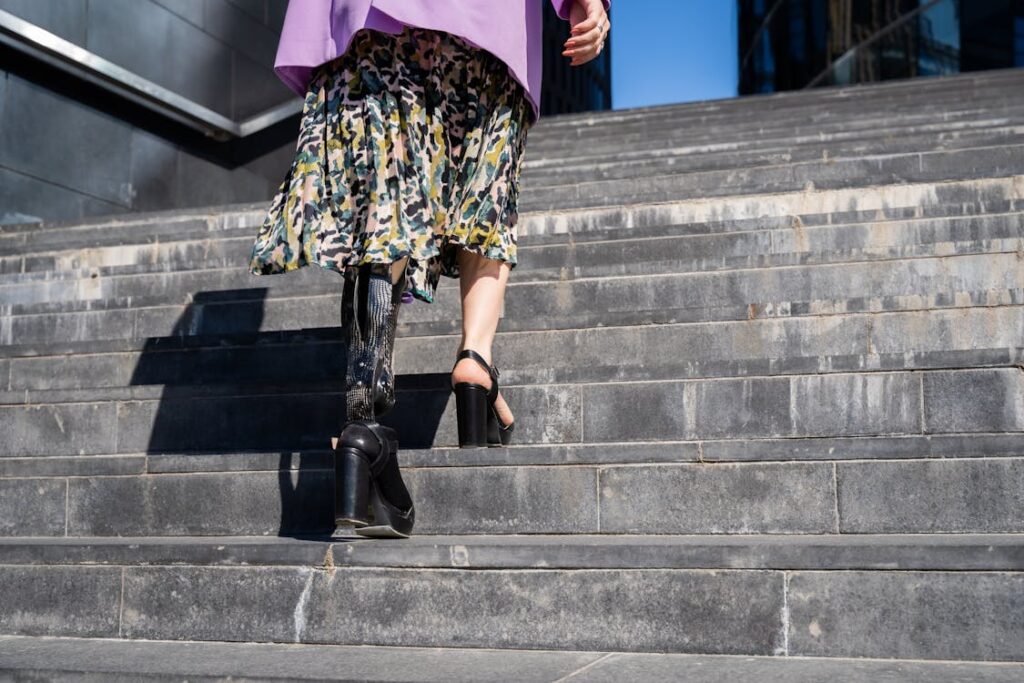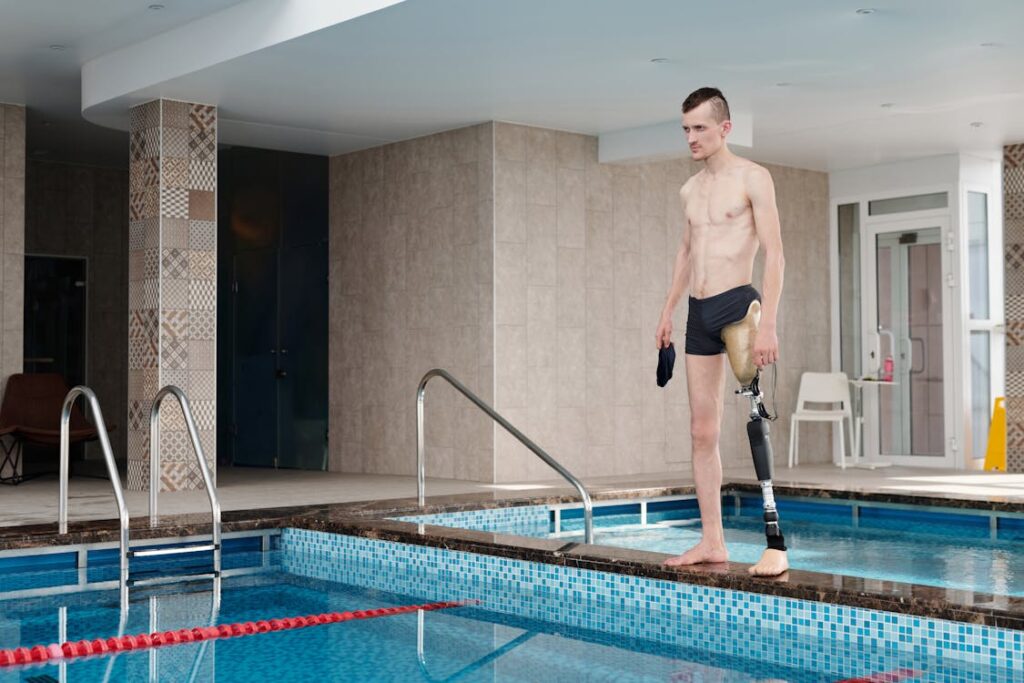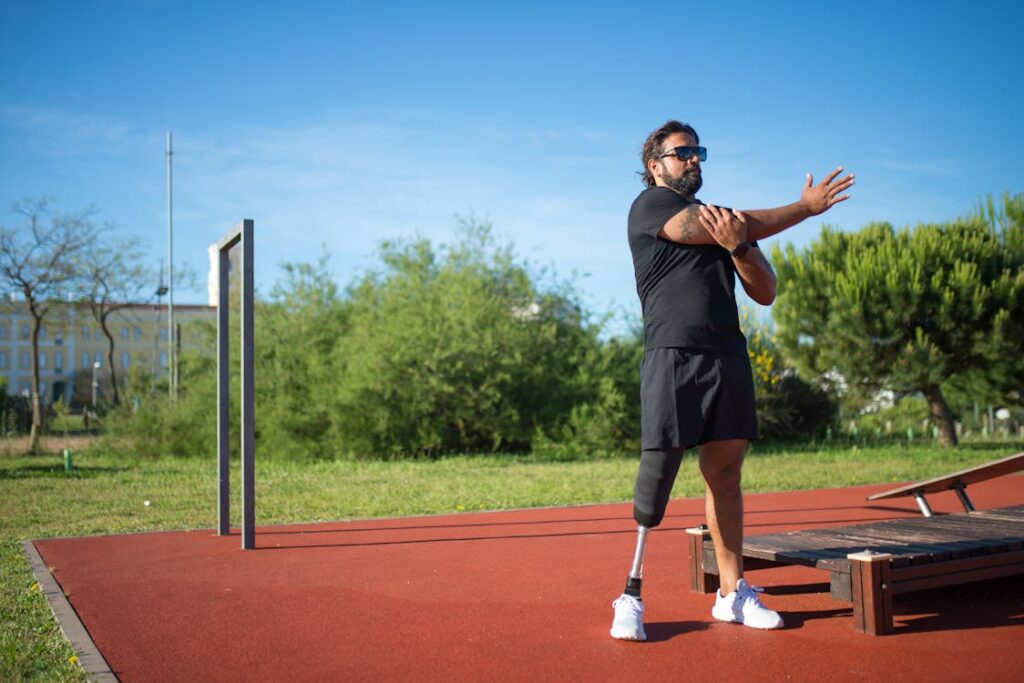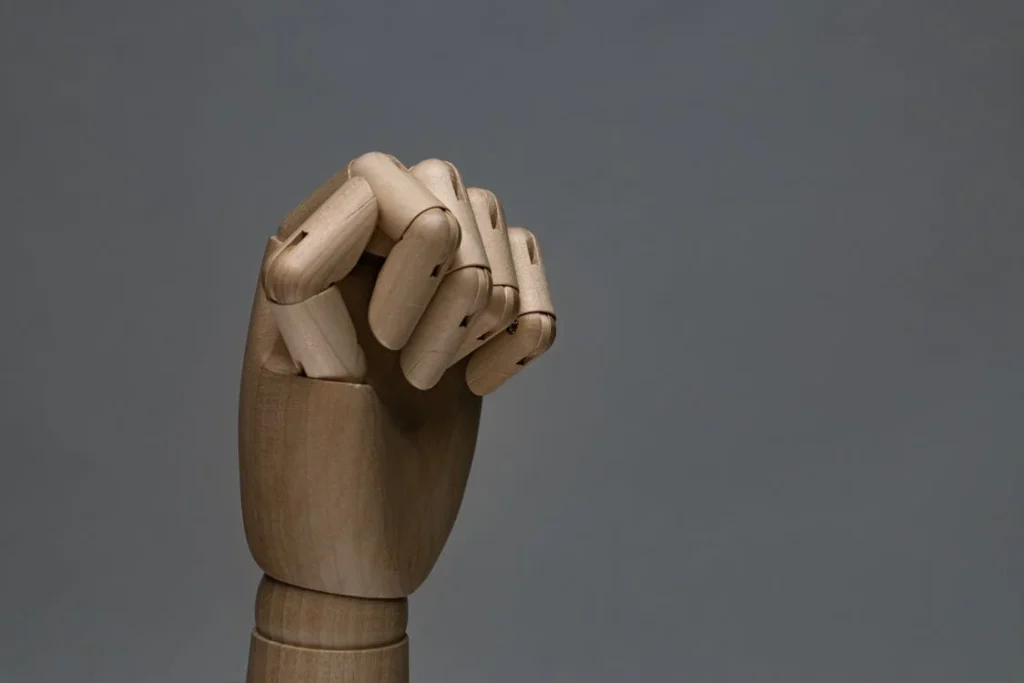For most people, walking feels simple. You stand up, move your legs, and off you go. But if you’ve lost a leg, walking becomes a whole new world. Each step takes thought. Every movement demands effort. That’s why modern prosthetic technology isn’t just about replacing a limb — it’s about recreating natural motion in the smartest way possible.
At Robobionics, we work closely with people who use prosthetic limbs every day. We’ve seen their struggles, heard their stories, and helped them find better solutions. One of the most exciting developments we’ve seen is energy-storing prosthetic feet and legs. These are not just tools. They’re carefully crafted systems designed to bring back a sense of natural motion, speed, and balance.

How the Human Leg Stores and Uses Energy
To understand energy-storing prosthetic legs and feet, we need to first look at how a natural leg works during walking or running.
Our bodies are amazing machines, and every step we take is powered by a simple but clever system of muscles, tendons, and bones.
The Natural Spring in Your Step
When you walk, your leg isn’t just moving forward—it’s storing and releasing energy, just like a spring. Imagine jumping on a trampoline.
When you land, the trampoline stretches and stores energy. As you push off, that stored energy bounces you back up. Something very similar happens in your leg.
Your Achilles tendon, located just above your heel, plays a big part in this. When your foot hits the ground, the tendon stretches slightly. This stretch stores energy.
As you lift your heel to take the next step, the tendon snaps back into shape, releasing that energy to push you forward. It’s quick, automatic, and efficient.
This same system works when you run, jump, or even go up stairs. Your muscles create power, but your tendons and ligaments make movement smooth and less tiring by recycling that energy.
What Happens When the Leg is Gone?
If someone loses a leg below the knee, they lose more than just the ability to stand or walk. They lose the natural spring built into their body.
They can no longer store and release energy in the same way. This makes walking feel heavy, slow, and awkward. The body has to work harder, using other muscles in ways they weren’t meant to.
Even with a basic prosthetic foot, walking can still feel stiff. Many traditional prosthetics don’t return much energy. They feel like blocks—functional but lifeless.
That’s why energy-storing prosthetics were developed: to bring back that spring, to give motion a more natural flow.
What Makes a Prosthetic “Energy-Storing”?
At first glance, an energy-storing foot or leg looks like a sleek, curved piece of material. But there’s much more going on beneath the surface.
It’s All in the Materials
Most energy-storing prosthetics are made with lightweight but strong materials like carbon fiber. Why carbon fiber?
Because it bends and flexes without breaking, and more importantly, it stores and returns energy, just like the Achilles tendon does in a biological leg.
When you step on an energy-storing foot, the carbon fiber flexes and takes in that force. Then, as you push off, it springs back into place, pushing you forward. It may sound simple, but the effect is powerful.
Users often report walking feels smoother, faster, and far less tiring.
The shape of the prosthetic also plays a key role. Many energy-storing feet are curved or blade-like. This design isn’t just for style—it helps the foot absorb impact better and return energy more effectively.
The curve also creates a rolling motion, making each step feel more natural.
Not Just for Athletes
You might have seen athletes using blade-shaped legs in running events. But energy-storing prosthetics aren’t only for the fast and fit.
Today, many models are made for everyday users—those who want to walk to the market, play with their kids, or go for a stroll in the park without getting tired.
At Robobionics, we offer models for both high-activity users and those who want more comfort in daily life.
Whether you’re looking to get back to work or simply enjoy a walk again, we help match you with the right foot or leg that fits your goals and lifestyle.

How Energy-Storing Prosthetics Improve Daily Movement
People often think of walking as just moving from one place to another. But for someone using a prosthetic leg, it’s more than that. Every step must be planned.
Each surface—whether smooth tile, gravel, grass, or stairs—becomes a new challenge. Energy-storing prosthetics change that by making movements feel more natural and automatic.
The Power of Push-Off
Let’s go back to what happens during a step. When your heel hits the ground, your body starts preparing to lift the foot again.
A normal leg uses the calf muscle and the Achilles tendon to store energy and push off the ground smoothly.
With traditional prosthetics, this part of walking is the hardest. There’s no spring action. The user has to lift the leg without much help, which takes extra energy and leads to a slower, clunkier step.
Energy-storing prosthetics are designed to fix this. The carbon fiber in the prosthetic bends as weight is applied.
Then, as the user moves forward, it releases that energy and helps push the leg up and ahead. It’s like getting a gentle boost with every step. This makes walking feel lighter and helps reduce strain on the hips and back.
More Balance, Less Effort
Walking on uneven ground is tough for anyone, but even more so if you’re wearing a prosthetic. Energy-storing feet are built to adjust to small changes in terrain.
Some models even have split-toe designs, allowing them to grip the ground better on sloped or bumpy surfaces. This improves stability and helps prevent falls.
Users also report less pain and fatigue. Why? Because the foot does more of the work. It helps carry the load and returns energy that would otherwise be lost.
That’s less pressure on the joints and muscles that often end up compensating when someone has a prosthetic.
This means users can walk farther, for longer periods, without feeling exhausted. Many even report better posture over time, as the improved gait keeps their body more aligned.
A Real-World Example
Take someone who works on their feet all day—maybe a teacher or a shopkeeper.
With a basic prosthetic foot, they may start the day strong but feel drained halfway through. Their body overworks itself to make up for the stiff, unresponsive foot.
Now imagine the same person using an energy-storing foot. With every step, they get a small return of energy.
They’re not dragging the leg; they’re moving with it. Their body doesn’t have to strain as much. They end the day with more energy and less discomfort. That’s a big difference.
The Role of Design in Energy-Storing Prosthetics
These prosthetics are more than just smart materials. They’re the result of thoughtful design choices.
At Robobionics, we take great care in how we shape and build every lower-limb prosthetic to ensure comfort, durability, and performance.
Custom Fit, Personalized Function
Everyone’s body is different. So it’s not enough to just offer a standard model. That’s why we start with a detailed evaluation for each user.
We look at their height, weight, walking pattern, lifestyle, and goals. Then we match them with a prosthetic that fits their body and needs.
A tight, secure fit is important—not only for comfort but also for energy transfer. If a prosthetic is loose or unstable, energy can’t flow properly from the ground up through the leg.
That’s why we focus on building well-matched socket systems and alignment.
Once the fit is perfect, we walk the user through a demo period. This trial phase helps them understand how the prosthetic moves and how to make the most of it.
If changes are needed, we adjust quickly and locally—another benefit of working with a homegrown brand like Robobionics.
Durable and Easy to Maintain
Our energy-storing prosthetics are built to last, even with everyday use. But like any technology, they need regular care.
We make that easy with local repair support, so users don’t have to send their devices abroad or wait for long service times.
Our prosthetics are also NABL-certified, meaning they meet strict national quality standards. This ensures every product is safe, reliable, and ready for real life.

Everyday Life With Energy-Storing Prosthetics
Energy-storing prosthetics are not just about technology—they’re about freedom. Freedom to walk longer. Freedom to play with your children.
Freedom to go to work or travel without constantly worrying about pain or fatigue. They’re designed to blend into real life, and to help people live it with ease and confidence.
Moving Through the Day with Confidence
From morning routines to errands in the afternoon and social events in the evening, our legs carry us through everything.
If you’re using a prosthetic that feels stiff or heavy, even simple tasks like climbing stairs or walking across a wet floor can feel risky.
Energy-storing prosthetics reduce that fear. Because of their responsive design, they support more natural movement.
When you go from sitting to standing, walk through crowded places, or take long steps to cross the street, the foot moves with you. It’s less like wearing a device and more like moving with a partner.
At Robobionics, we’ve worked with people from all walks of life—parents, students, farmers, professionals.
Each has a different routine, but they all share one goal: they want to move with less pain and more ease. With the right prosthetic, they get just that.
Standing for Hours Without Breaking Down
If you’ve ever had to stand for hours at work, you know how quickly discomfort sets in. Now imagine doing that with an unresponsive foot.
The pressure builds in the back, knees, and hips. Over time, this leads to posture issues and joint pain.
Energy-storing prosthetics spread that pressure more evenly. They absorb shock when your foot hits the ground and help push your body back up during walking.
This keeps your weight more balanced and helps avoid long-term health problems that can come from overcompensating with the rest of the body.
We often hear from users who say their back pain reduced after switching to energy-storing legs. That’s not magic—it’s just good design doing what it’s meant to do.
Want a prosthetic that fits your workday, not the other way around? Talk to our team to learn more about our adaptive prosthetic solutions and get matched with the right fit.
From Walking to Running: High-Activity Models
While many people use prosthetics for walking and standing, others have more active goals. Maybe it’s jogging in the park, playing sports, or hiking on a weekend trip.
For these users, energy-storing prosthetics offer something truly powerful: the chance to be active again.
Built for Action
High-activity models of energy-storing feet are shaped differently from walking feet. They are often longer, with a curve that looks more like a blade.
This design isn’t just for appearance—it allows the foot to bend further and return more energy. That means faster, stronger motion for activities that require quick steps or strong push-offs.
These feet are also incredibly light. Reducing weight is important for performance. The lighter the prosthetic, the less drag it creates when running or jumping. That means smoother movement and more comfort overall.
We’ve seen users who thought they’d never run again step back into sports with a smile. With proper training, support, and the right fit, high-energy prosthetics can bring back the joy of movement.
Training Makes All the Difference
Getting a high-performance prosthetic is just the start. Learning how to use it effectively is where real transformation begins.
That’s why we offer gamified rehabilitation—a smart, engaging way to rebuild strength, balance, and confidence at home.
Through our program, users practice real movements in fun ways using interactive software.
This makes learning faster, and often more enjoyable than traditional rehab methods. Plus, the more you train, the more natural the prosthetic begins to feel.
We guide every user step by step. From first fitting to mastering motion, we’re there through the whole process.

Innovation in Energy-Storing Prosthetic Technology
Technology in prosthetics has come a long way, especially in the last two decades. What started as simple wooden pegs has now grown into sophisticated systems that mimic human motion.
And energy-storing prosthetic feet and legs sit right at the center of this progress.
Smarter Designs Through Research
One of the biggest reasons energy-storing prosthetics are so effective today is because of how much research has gone into making them better.
Engineers, doctors, and designers have spent years studying the human gait cycle—how people naturally walk—and developing ways to recreate it in prosthetic form.
Every part of the foot is carefully considered. The heel is shaped to absorb shock. The arch flexes to store energy.
The toe region helps deliver that final push. Materials are tested for strength, flexibility, and how well they return energy with each step.
Robobionics has built on this global research by adding something unique—local knowledge and on-ground feedback from Indian users. We’ve learned that climate, terrain, and lifestyle all affect how a prosthetic performs.
That’s why we focus on building prosthetics that are not only advanced but also made to handle the dust, heat, and variety of movement seen in everyday Indian life.
Smarter Features with Simpler Use
Modern energy-storing legs are also becoming more adaptive. Some now come with adjustable heel heights, which allow users to change their shoes or switch from flat surfaces to slopes more easily.
Others have micro-adjustable joints that allow better tuning based on the person’s speed and activity level.
What makes this so powerful is that these improvements don’t make the prosthetic more complicated. On the contrary, newer models are designed to be easy to use, maintain, and adapt.
They’re intuitive, meaning once they’re on, users barely have to think about how they work. The foot simply responds, as a natural limb would.
This simplicity is key. It builds confidence and allows users to focus on living their lives, not managing a piece of equipment.

Looking Ahead: The Future of Energy-Storing Prosthetics
The journey doesn’t end here. New technologies are already on the horizon that promise to make energy-storing prosthetics even better.
Integrating Sensors and AI
Imagine a prosthetic that adjusts itself in real-time based on how you walk, or one that learns your movement habits and tunes its response to match. This is the future we’re building towards with sensor-driven systems and AI.
Early versions already exist and are being tested globally. At Robobionics, we’re working on bringing such innovations into the Indian market in a way that’s affordable, reliable, and easy to use.
We believe the future of prosthetics is intelligent—where the limb doesn’t just respond but thinks along with you.
Building Stronger Communities
Technology alone isn’t enough. Support systems matter too. That’s why we’re expanding our network of clinics and rehab centers, partnering with NGOs, and launching CSR programs to reach underserved areas.
We also organize training programs for prosthetists and therapists, so more people across India have access to expert care.
Our goal is simple: make sure every person who needs a prosthetic can find one that works beautifully—and have a team that supports them from day one.

The Emotional Impact of Movement: More Than Just Mobility
A prosthetic leg is not just a mechanical replacement. It’s a part of someone’s identity. When mobility is restored, something else powerful happens—confidence returns.
Walking Back Into Confidence
After limb loss, many users go through emotional ups and downs. Even when physical healing is complete, the mental recovery can take longer.
The fear of falling, the struggle to keep up with others, or the worry of how people might stare—all of these weigh heavily on someone trying to adapt.
Energy-storing prosthetics change that story. Because they enable smoother, quicker, and more natural movement, users often regain the freedom to participate in society without self-consciousness.
Walking confidently into a room. Crossing the street with ease. Dancing at a family event. These moments may seem small, but they restore dignity in big ways

Pediatric Energy-Storing Prosthetics: For Young Dreamers
Children are full of energy, curiosity, and imagination. But a child with limb loss often faces barriers—not only physical but social and psychological.
That’s why designing prosthetics for children is both a technical and emotional task.
Not Just a Smaller Version
Pediatric prosthetics need to support growth, play, and learning. An energy-storing foot for a child must handle more jumping, running, and unexpected movements. It must also be adjustable over time, as the child grows.
At Robobionics, we build child-friendly prosthetic feet that combine flexible carbon materials with playful design. The goal is to keep kids moving—and smiling.
Some models come with colorful finishes or lighter frames, so they look and feel less like a “medical device” and more like a part of the child’s personality.
We also work with parents to ensure they understand how to manage fittings, when to come in for size checks, and how to encourage active habits at home.
Designing for Women: Prosthetics With a Personal Fit
While many prosthetics are labeled as “universal,” gender matters—especially when it comes to fit, flexibility, and comfort.
Women’s lower limbs differ in muscle mass, stride length, and hip width. Ignoring these differences can lead to pain, poor alignment, and decreased confidence.
Built for Balance and Lifestyle
At Robobionics, we take gender-specific biomechanics seriously. Our prosthetic systems for women are built to reflect natural gait patterns, smaller frame proportions, and common footwear needs.
We also recognize lifestyle differences—like walking with sarees or standing for long hours while managing home and work responsibilities.
Our goal is not just to deliver a device—it’s to deliver a better everyday experience for women across all age groups.
Bridging the Gap in Rural India: Accessible Technology
In cities, people have better access to rehab centers, specialized clinics, and follow-up services. But in rural areas, provision of prosthetic care remains a challenge. Robobionics is working hard to change that.
Taking Technology to the Grassroots
We partner with regional clinics, NGOs, and mobile units to deliver prosthetics and training directly to villages.
Our energy-storing foot models are engineered to withstand rugged terrain, extreme temperatures, and long-term daily use. More importantly, they are affordable and don’t rely on overseas support.
We also run awareness programs to help communities understand that limb loss is not the end of independence.
By sharing success stories and providing local fitment drives, we help normalize prosthetic use and encourage those in need to come forward.
The Role of Feedback: How Users Shape Our Designs
No matter how advanced a prosthetic is, it means nothing if it doesn’t work for the user. That’s why Robobionics treats user feedback as the most important part of our innovation cycle.
Designed With You, Not Just For You
We don’t just test our products in labs. We test them in real homes, on real streets, in real workplaces. We talk to users, listen to what’s working—and what isn’t.
Their suggestions have led us to improve flexibility, reduce weight, increase ground grip, and adjust socket comfort.
It’s this co-creation model that helps us build prosthetics that truly fit life as it’s lived.
Conclusion
Energy-storing prosthetic feet and legs are more than just engineering—they’re empowerment. They restore the rhythm of walking, the ease of movement, and the dignity that comes with independence. At Robobionics, we believe that everyone deserves to walk with confidence, whether it’s to work, to play, or simply to live life on their own terms.
Through thoughtful design, local expertise, and a deep commitment to care, we bring cutting-edge prosthetic solutions that fit real lives—not just measurements. From children rediscovering play to adults embracing activity again, our energy-storing limbs are rewriting stories of possibility across India.
If you’re ready to experience the difference, don’t wait. Book your free demo with Robobionics today and discover how the right prosthetic can help you move freely, live fully, and dream bigger.
Let every step be a celebration. Your journey starts here.



